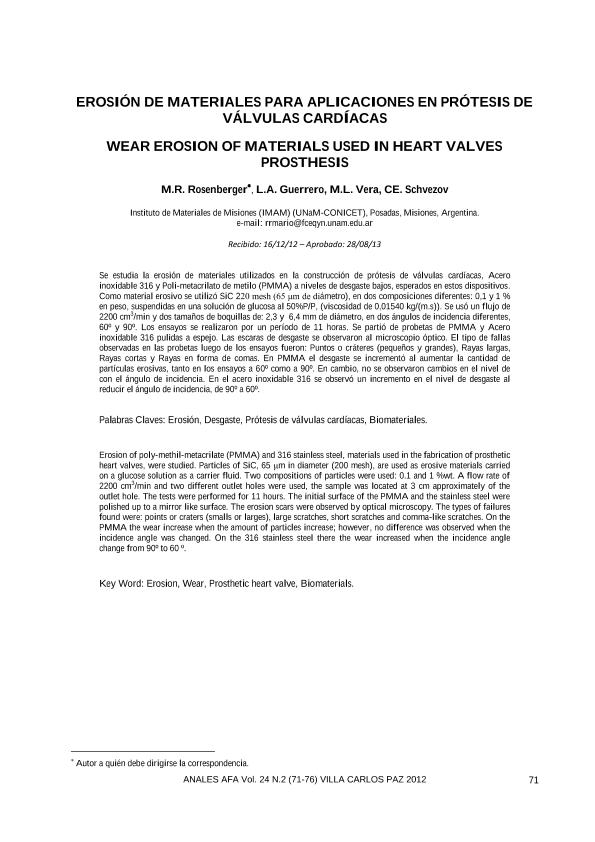Artículo
Se estudia la erosión de materiales utilizados en la construcción de prótesis de válvulas cardíacas, Acero inoxidable 316 y Poli-metacrilato de metilo (PMMA) a niveles de desgaste bajos, esperados en estos dispositivos. Como material erosivo se utilizó SiC 220 mesh (65 μm de diámetro), en dos composiciones diferentes: 0,1 y 1 % en peso, suspendidas en una solución de glucosa al 50%P/P, (viscosidad de 0,01540 kg/(m.s)). Se usó un flujo de 2200 cm3/min y dos tamaños de boquillas de: 2,3 y 6,4 mm de diámetro, en dos ángulos de incidencia diferentes,60º y 90º. Los ensayos se realizaron por un período de 11 horas. Se partió de probetas de PMMA y Acero inoxidable 316 pulidas a espejo. Las escaras de desgaste se observaron al microscopio óptico. El tipo de fallas observadas en las probetas luego de los ensayos fueron: Puntos o cráteres (pequeños y grandes), Rayas largas, Rayas cortas y Rayas en forma de comas. En PMMA el desgaste se incrementó al aumentar la cantidad de partículas erosivas, tanto en los ensayos a 60º como a 90º. En cambio, no se observaron cambios en el nivel de con el ángulo de incidencia. En el acero inoxidable 316 se observó un incremento en el nivel de desgaste al reducir el ángulo de incidencia, de 90º a 60º. Erosion of poly-methil-metacrilate (PMMA) and 316 stainless steel, materials used in the fabrication of prosthetic heart valves, were studied. Particles of SiC, 65 μm in diameter (200 mesh), are used as erosive materials carried on a glucose solution as a carrier fluid. Two compositions of particles were used: 0.1 and 1 %wt. A flow rate of 2200 cm3 /min and two different outlet holes were used, the sample was located at 3 cm approximately of the outlet hole. The tests were performed for 11 hours. The initial surface of the PMMA and the stainless steel were polished up to a mirror like surface. The erosion scars were observed by optical microscopy. The types of failures found were: points or craters (smalls or larges), large scratches, short scratches and comma-like scratches. On the PMMA the wear increase when the amount of particles increase; however, no difference was observed when the incidence angle was changed. On the 316 stainless steel there the wear increased when the incidence angle change from 90º to 60 º.
Erosión de materiales para aplicaciones en Prótesis de válvulas cardíacas WEAR
Título:
Erosion of materials used in heart valves prosthesis
Fecha de publicación:
08/2013
Editorial:
Asociación Física Argentina
Revista:
Anales Afa
ISSN:
0327-358X
Idioma:
Español
Tipo de recurso:
Artículo publicado
Clasificación temática:
Resumen
Palabras clave:
Erosión
,
Desgaste
,
Prótesis de Válvulas Cardíacas
,
Biomateriales
Archivos asociados
Licencia
Identificadores
Colecciones
Articulos(CCT - NORDESTE)
Articulos de CTRO.CIENTIFICO TECNOL.CONICET - NORDESTE
Articulos de CTRO.CIENTIFICO TECNOL.CONICET - NORDESTE
Citación
Rosenberger, Mario Roberto; Guerrero, L. A.; Vera, Maria Laura; Schvezov, Carlos Enrique; Erosión de materiales para aplicaciones en Prótesis de válvulas cardíacas WEAR; Asociación Física Argentina; Anales Afa; 24; 2; 8-2013; 71-76
Compartir




